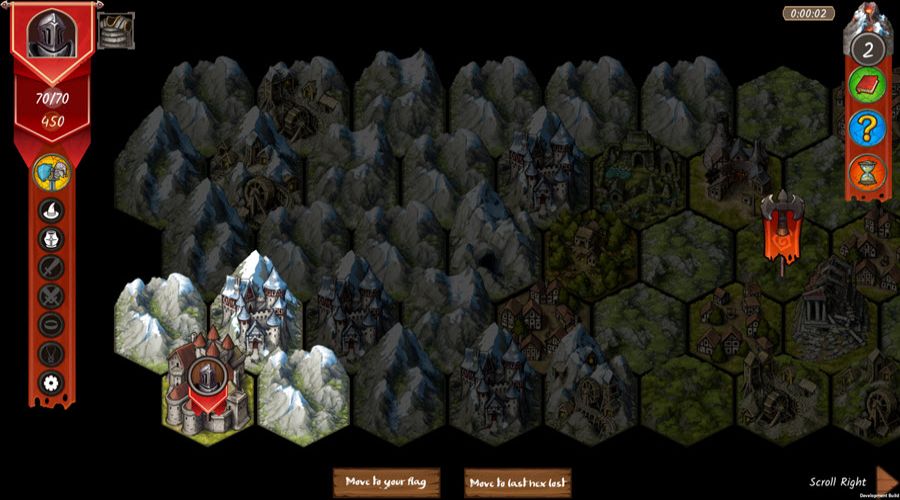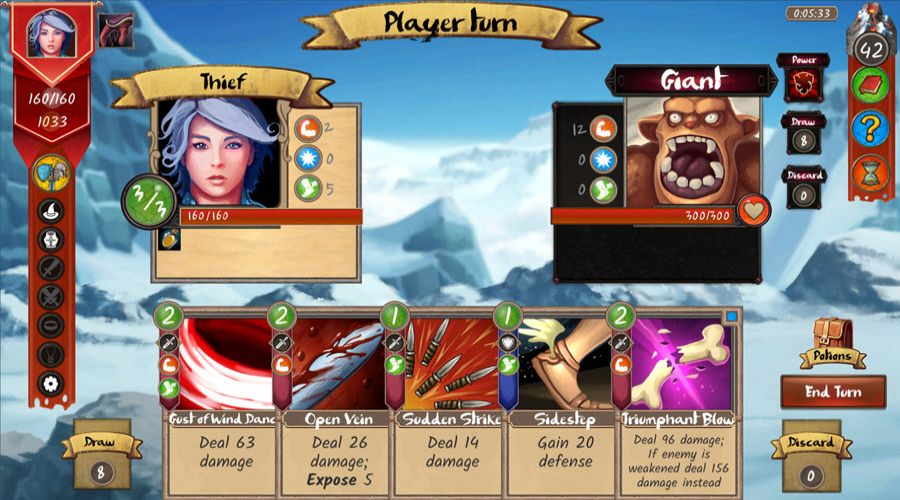The Last Hex

Review
Only you can stand against the dead and The Lost, slay monsters, survive events and take on mini-bosses as you make your way to The Last Hex, a deckbuilding RPG with rogue-like elements brought to you by That Indie Studio.
Upon starting a new game you’ll have the choice of which class you’d like to play as; the classes are Warrior, Wizard or Thief. There are several different portraits you can choose from for each class type.
Each of the classes has a skill that will give you a bonus within the game. The Warrior’s class skill is Armour Mastery, which will give you three defense points every round. The Wizard’s class skill is Energy Conduit, which gives you a small chance to deal critical damage every attack. The Thief’s skill is Five Finger Discount, which gives you a moderate discount in cities.
The starting stats of your character will depend on which class you choose to play. There are three different stat types: Power, Arcana and Expertise. Warriors start with two power, zero arcana and one expertise stats, wizards have zero power, two arcana and one expertise, while the thief has one power, zero arcana and two expertise. You can increase these stats through buying new equipment, like rings or necklaces. The more you increase a stat of your character the better effect your cards will have.

All classes have a starting card deck which may contain the same types of cards as in other classes. However, the stats of a class will give different values to a card. Every card has on it, the number of points needed to play the card, whether it’s for attack of defense, and its stat type. As a warrior you may collect a card which is arcana type and as you have no stats for arcana then it will not deal any damage when used. If you have one arcana stat or more through a ring or other equipment, then it will give some damage when used. So, the better your stats are, the better your cards will become.
You start with some basic equipment which you can upgrade by buying new equipment at any of the cities you enter. You’ll also start with 400 or 450 gold and can earn more from defeating monsters or from some events. In the cities you’ll also be able to rest to fully heal, and/or buy new equipment, new cards or potions. If you have enough gold, you can also train your character, which will add to one of the three stats of your choosing, or add to your maximum health points.
Once you’ve chosen your character and hit the start button, you’ll then head off to the world map; this map is randomly created each new game. Starting at the left-hand side of the map, you’ll have to make your way to the very end, which is quite some distance to travel and is not easy to reach. At the end of the map is where you’ll find The Lost and this will be your final fight. You make your way to the end of the map by moving from one hexagonal tile to another.
Each tile will consist of either Cities, Events or Camps; for those tiles without any of these, you’ll fight monsters upon moving to that tile. On Cities - you can rest or buy items. Events will either help or hinder your progress, and it’s up to you whether or not you want to take the risk of becoming stronger or gaining something else which will help you on your quest. In the Camps you’ll find mini-bosses, and if you defeat them, you’ll be rewarded with better cards or equipment. Each time you defeat a monster you’ll have the choice of picking one of three cards which will be added to your deck. Defeating a mini-boss will give you three cards for your deck and you can pick one of two equipment cards.
As you make your way towards The Lost, its strength will increase (this can also be increased by some of the choices you make). So, making the choice to take a gamble on an event etc may just come to bite you on the botty further down the line. The Lost starts with a strength of two points and you can keep an eye on how strong it’s becoming by checking the top right-hand corner. In the top right corner, it also shows you how long you’ve played this current game, along with a Compendium, Reference/Guide and Main Menu. On the left hand-side of the screen you’ll find details on your character, health, gold, character stats and equipment you currently own also any boons or curses.
You can find information on the Boons and Curses and the effects they’ll have either for or against you in the Reference/Guide book. Here you can also get more information on Objectives, Player, Cards, Equipment, Statuses and Tips for Survival.
As you buy new cards or equipment, defeat monsters or events you’ll unlock new cards, events and monsters as you progress. If you unlock new cards they’ll be added to your deck. With equipment, though, if you add a new item to your character, any item already there will be replaced, and the old item will be discarded. It would be nice at times to be able to sell these items, but you can’t, so make sure that you really want to change items before doing so as you can’t undo any mistakes.
When you enter a fight, you’ll normally start with three Energy Points, and five or so cards to use. Each of the cards has a certain number of energy points required to use that card, which is indicated in the top left of the card. If the card is for attacking, then you’ll move that card on to the monster and it will take effect. If the card is for defense, then you’ll move it on to your character. You’ll need to find that sweet spot of attacking while building up your defense each turn. Sometimes there’ll be cards in your deck from the current monster you’re fighting, like the Highwayman. This will place cards called Your Money or Your Life in your deck, you can play this card but in doing so you’ll suffer twenty damage; however, if you don’t play it then the highwayman will steal one hundred gold from you each time.
In the Compendium you’ll find information on your Player (Victories, Map Stats, Time Stats, Gold Stats and Fight Stats), Cards, Potions and Items (Owned and Unlocked and the rarity of those collected thus far), Unlocked Enemies and the Camp Bosses, along with any of the Achievements you’ve managed to collect so far.
In the settings there’s Resolution, Full Screen, Master Volume, Show Card Math, Unlock Everything and Reset Game Data.
I’ve quite enjoyed playing the game so far; it’s easy to learn but not so easy to master and can be quite challenging, which isn’t a bad thing. Graphics and music are good and there seems to be quite a few updates being made to the game, which is always nice to see. On the main menu screen, you can find a list of the patch notes.
Review written by Piston Smashed™ for Zeepond.com!
Positives
+ Easy to learn but still very challenging+ Fun and enjoyable game
+ Has achievements
Negatives
- Can be frustrating at times- No cards
Review Summary
Make your way through monsters, mini-bosses and events as you travel the lands to rid the world of The Lost on The Last Hex.
Share this review!
Zeepond Rating: 8/10










Video
Game Categories
All Game Reviews (1352)Hardware Reviews (0)
Action (341)
Adventure (151)
Alpha Games (2)
Anime (5)
Board Games (3)
Casual (135)
First Person (19)
First Person Shooter (30)
Hardware (0)
Horror (38)
Massive Multiplayer Online (4)
Pixel Graphics (22)
Platformer (94)
Puzzles (64)
Racing (26)
Role Playing Game (61)
Simulation (53)
Sports (20)
Strategy (246)
Third Person (11)
Utility software (1)
Virtual Reality (22)

